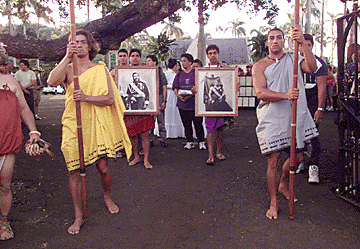 Return to the Hawaiian Independence Home Page, or the News Articles Index
Return to the Hawaiian Independence Home Page, or the News Articles Index


By Ken Ige, Star-Bulletin
Portrait bearers carry the images of King Kalakaua and Queen Liliuokalani
out the front gate of Mauna'ala on Nuuanu Avenue,
as they begin the walk to Iolani Palace.
Ceremonies 'make things right'
Rites at the Royal Mausoleum honor Hawaiian ancestors, bring 'a rebirth' on the centennial of U.S. annexation
Honolulu Star-Bulletin
August 12, 1998 By Helen Altonn
Star-Bulletin
More than 300 Hawaiians and supporters gathered in the dark this morning at the Royal Mausoleum in Nuuanu to honor their ancestors and "make things right."
Then a march to Iolani Palace that grew to 1,500 to 2,000 participants treated spectators to a grand view of Hawaiian culture and tradition.
"God bless them all," said Gloria Rodrigues, waiting for the procession to pass so she could cross Beretania Street by the Pali intersection.
The marchers, many dressed in traditional Hawaiian attire, carried a board with copies of a petition signed by those who opposed Hawaii's annexation by the United States 100 years ago today.
A solemn and reverent mood prevailed during ceremonies at the mausoleum, and marchers were happy and peaceful as they began their nearly 5-mile trek at 7 a.m.
Undaunted by warm, muggy conditions, they carried portraits of Hawaii's eight monarchs and Liloa, an ancient Big Island chief. "Most of us descended from him," said Keanu Sai, Hawaiian Patriotic League president.
They carried a 25-foot sash of Liloa, made of red and gold 'i'iwi and 'o'o bird feathers, on loan from the Bishop Museum. The sash, regarded as a link between the alii (Hawaiian royalty) and common people, was honored in private ceremonies at dawn in the mausoleum chapel.
The marchers bore kahili (feathered standards), palm branches and signs representing their families and protesting annexation, such as, "U.S. Out of Hawaii."
They chanted and blew conch shells as they walked down Nuuanu Avenue to Beretania Street, then Diamond Head to Washington Place and the palace.
They carried babies and pushed strollers and wheelchairs. Kerri Kahapea Aquino's daughter, Kaulii, 1-1/2, rode in style in a red wagon decorated with palms and a Hawaiian flag.
Among marchers was Noenoe Silva, University of Hawaii doctoral student in political science, whose research in the National Archives in Washington, D.C., uncovered 1897-98 petitions of Hawaiians against annexation.
Kuulei Anakalea, 50, and Diane Amadeo, 60, both of Maui, searched the signatures in an exhibit of the petitions at the Capitol today and found many ancestors. "This is my tutu," Anakalea said, pointing with excitement.
"We only hear about genealogy," Amadeo said. "Coming here and looking at what they (ancestors) did at the time, signing their own signatures, just gives you goose bumps."
Silva credited Nalani Minton with the idea to publicize the petition containing 21,169 native Hawaiian signatures with a Bishop Museum exhibit and a book.
"This is just the beginning. This movement, this energy, gives me courage to study this, to bring it out."
The marchers paused at Washington Place where a group entered and gave hookupu (offerings) before proceeding to Iolani Palace for a flag-raising ceremony.
Kamile Featheran, 64, said she was feeling "just awesome" about the activities.
"It's a new life, a rebirth. We found the truth: that there was no annexation and, most importantly, those who petitioned the president at that time worked so hard" against annexation, she said. "Today we honor them."
Watching the Hawaiian flag being raised today at the palace, where it was replaced with the U.S. flag 100 years ago, was Kahili Kawainui, 58. She found many of her kupuna (elders) on petitions signed by Hawaiians against annexation, including Solomona Panaewa, her great-grand uncle.
He was alive when she was a child and told her that when he was in the Royal Guards at age 25, he helped remove the Hawaiian flag, she said. "It was very traumatic for him."
Lono Montgomery, 34, said he had participated in the march around Oahu.
"We cleansed each section as we went around," he said, explaining: "Fire represents change. Sometimes we have to burn the old for the new to happen. We were burning old feelings.
"Today represents bringing new life and bringing alii back to the palace."
© 1998 Honolulu Star-Bulletin
http://starbulletin.com


Return to the Hawaiian Independence Home Page or the News Articles Index
